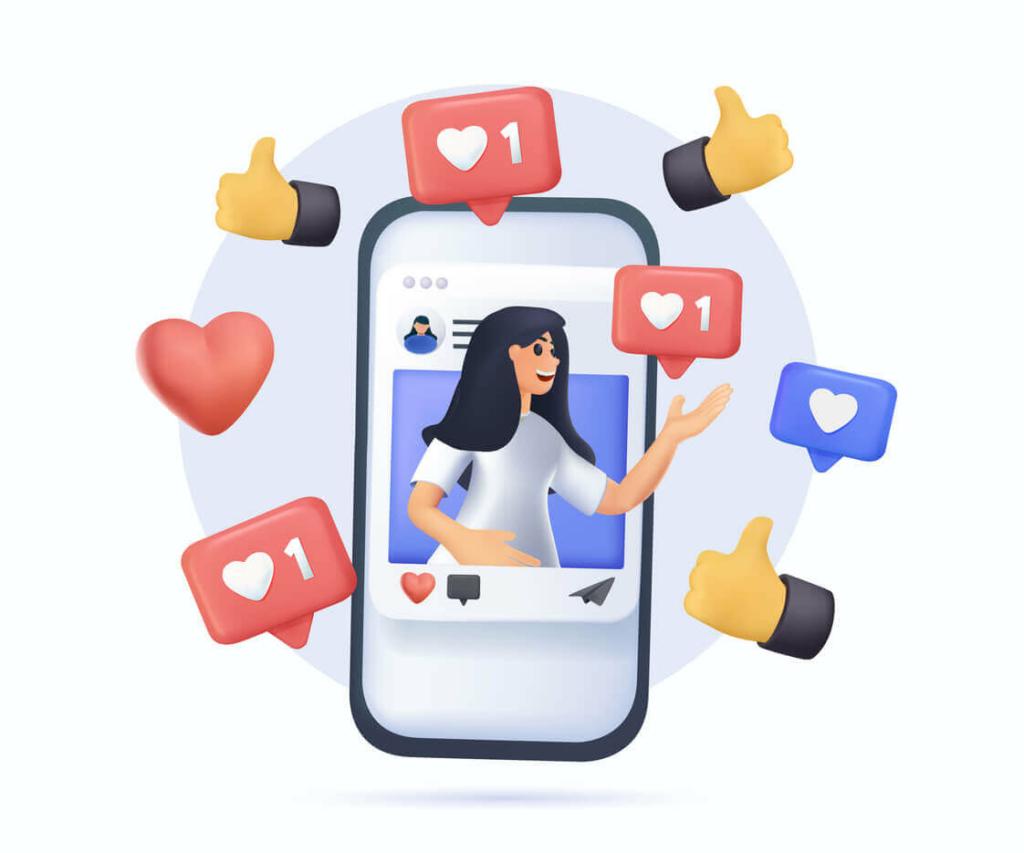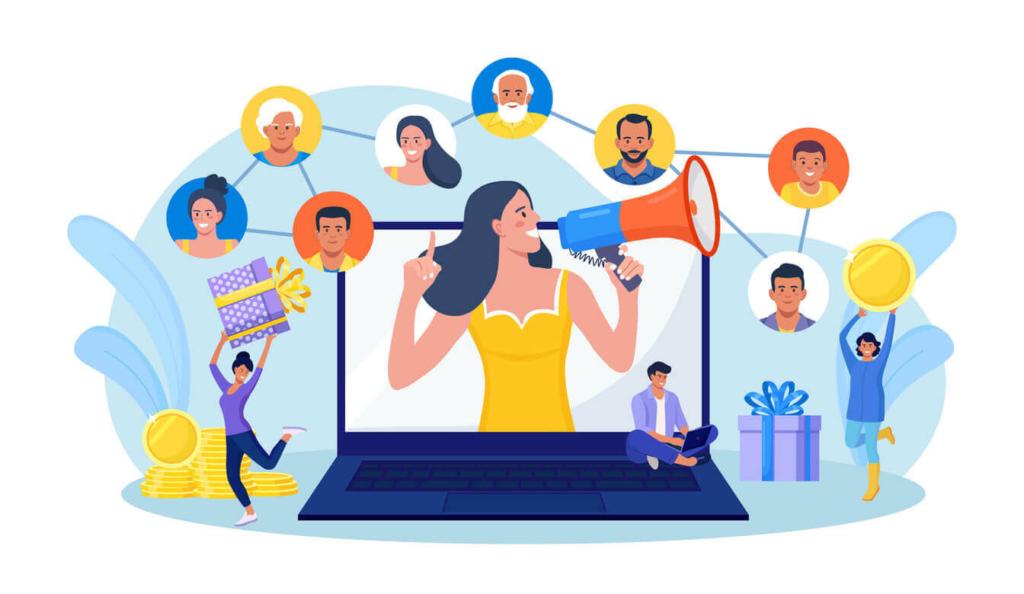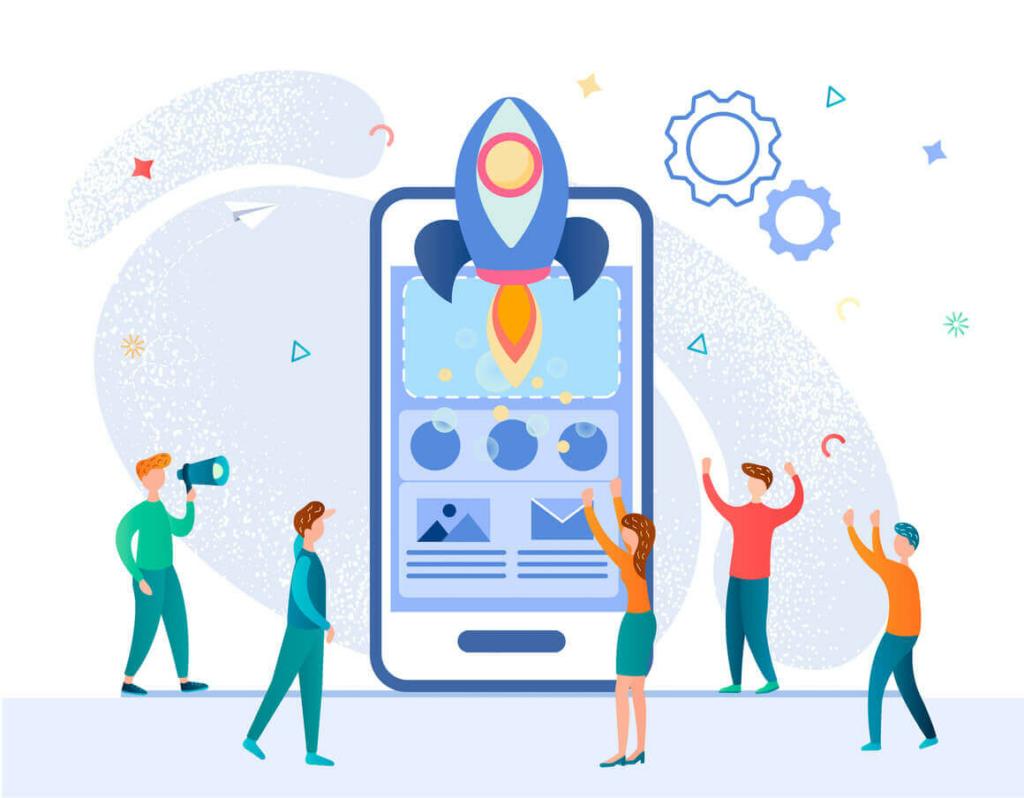Social media is a powerful tool for app marketing, especially if you’re just starting. It can help your start-up reach a large and diverse audience, showcase your app’s unique value proposition (UVP), generate buzz and engagement, drive traffic and conversions, and build a loyal community of users.
But how do you effectively leverage social media to market your app in 2025? What are the best marketing strategies and platforms? How do you measure your success and optimize your campaigns? This article will answer these questions and more.
We’ll share the essentials of social media app marketing and explain five innovative and proven tactics for launching or re-launching your app with a bang! Let’s dive in.
The Essentials of Social Media Marketing for Apps
There are projected to be 5.17 billion people using social media worldwide in 2024[1], which means your app’s potential reach is vast. However, to truly tap into this audience, you must have a solid foundation in the core principles of social media app marketing, which involves knowing where and how to post in a way that resonates with your audience.
To achieve this, here are four steps to follow.
1. Identify Your App’s UVP
UVP is a standout feature or benefit that makes you stand out in a crowded market and compels people to choose your app above others. Your UVP answers the question, “Why should someone download and use your app?” It’s what makes your app different, better, and more attractive to the people you want to reach.
By clearly defining and effectively communicating your UVP, you can connect with your audience and show them exactly how your app will solve their problems and improve their lives. For example, a language learning app might have a UVP of “Learn a new language in just five minutes a day.” This UVP highlights the app’s key features and benefits, such as time efficiency and ease of learning.
To identify your app’s UVP, you need to conduct a target audience analysis and competitive assessment:
Target Audience Identification and Analysis

Understanding your ideal audience is crucial. If your app is a budgeting tool for young professionals, your audience might be millennials starting their careers. Therefore, social media analytics tools like Google Analytics, TikTok Analytics, and Facebook and Instagram Insights can help you learn their interests, online behavior, and peak activity times.
Proceed to create detailed buyer personas for your social media app marketing and segment them into different groups based on their characteristics and needs.
Competitive Landscape Assessment
Understanding the competitive landscape helps you to identify, research, and evaluate competitors to collect insight to inform your business strategy. The goal of your social media app marketing campaign isn’t to copy your competition but to learn from them and find ways to offer something better or different.
Here’s a checklist to conduct your competitive analysis:
| Competitive Analysis | Description |
| Identify Your Competitors | List out other apps that offer similar features or target similar audiences — these are your direct competitors. Then, consider apps that might not be the same but could still satisfy similar user needs — these are your indirect competitors. |
| Analyze Their Strategies | Look at how these competitors present themselves — the features they highlight, their engagement with their audience, and social media app marketing tactics. These will give you insight into what works and doesn’t in your market. |
| Learn From Their Strengths and Weaknesses | Identify what your competitors do well so you can aim to match or exceed those standards. More importantly, by recognizing their weaknesses, you can identify opportunities to differentiate your app and fill gaps they’ve left open. |
| Craft Your Unique Selling Points (USPs) | Use your analysis to define what makes your app unique, like a particular feature, user experience, design, or brand story. Your USPs explain why users should care about you. |
| Apply Your Findings | Use the insights from your competitive analysis to inform your marketing strategy. If you find that all competitors are using video marketing effectively, consider how you can create even more engaging video content. If competing apps have a common complaint, address that pain point and highlight it in your marketing. |
2. Select the Best App for Social Media Marketing (SMM)

You don’t need to be on every social media platform to market your app effectively. Spreading yourself too thin can dilute your impact and waste your resources. Instead, you should focus on relevant and suitable platforms for your app, audience, and goals. But what is the best app for social media marketing?
Different social media platforms appeal to various audiences. Instagram and TikTok might be best for reaching young adults, while Facebook and X (formerly Twitter) might be better for reaching an older demographic.
![Image from Statista showing a bar chart of monthly active users in millions as of January 2024 on various social media platforms used for social media app marketing[2].](https://nuoptima.com/wp-content/uploads/2024/03/image3-2.png)
| Social Media Platform | Best For | Description |
| Visual Engagement | Ideal for showcasing your app’s visual content, where users can post screenshots, Stories, short videos (Reels), and live streams of your app in action. Use Instagram Stories for quick tips or updates. It’s ideal for apps with strong visual appeal, such as travel, lifestyle, gaming, or entertainment. |
|
| TikTok | Creative Content | TikTok is all about creativity and trends. Statista reports that the platform boasts over 1.7 billion monthly active users, with at least 36% being between 18 and 24 years old[3]. You can create fun, engaging videos that show your app in action, participate in trending challenges, and use popular music to boost your visibility. However, TikTok is a video-first platform, and ad campaigns can be costly. For more information and tips, check out our TikTok marketing guide. |
| Community Engagement | You should consider Facebook to reach a broad and mature audience between 25 and 34 years old. According to Statista, this audience makes up 31% of Facebook’s users[4].Facebook is great for building communities. It’s the world’s largest and most diverse social media platform. You can create a Facebook community for your users to share tips, ask questions, and provide feedback. So, engage them by posting regular updates, handy tips, and inspiring stories from users who love your service. | |
| YouTube | In-Depth Demonstrations | To target young and curious audiences – with almost 2.5 billion monthly active users, 21% of them between 25 and 34 years old[5] – YouTube is a platform you should leverage. It is perfect for detailed live streams, walkthroughs, or tutorials – generally, hands-on training. Create videos that show how to use your app, explain its features, and demonstrate its benefits. |
| X (Formerly Twitter) | User Connecting and Engagement | X enables real-time participation and conversation with a worldwide audience. It’s excellent for promoting your app via paid advertising and influencer marketing and establishing a strong community around your business. However, a defined plan and continuous presence are required to stand out among the noise. |
These are just some of the most popular and effective social media app marketing platforms. Depending on your app’s niche, audience, and goals, you may also want to explore other platforms like LinkedIn, Pinterest, Snapchat, or Reddit. In short, your research should guide you in choosing the platforms that fit your app’s UVP and the people you want to reach.
3. Amplify Your Message With Influencer Partnerships

Influencer partnerships can significantly boost your message. For instance, a fitness app could partner with fitness social media app marketing influencers who can share their experiences using the app, offer exclusive workout routines, or host challenges with their followers.
Benefits of Influencer Collaboration
- Increase brand visibility and awareness and boost app downloads. Influencers can bolster your social media app marketing by spreading the word and allowing you to tap into their massive audience following.
- Enhance social proof. According to Nielsen, 92% of consumers trust earned media, such as word-of-mouth (WOM) recommendations, more than any other form of advertising[6]. When influencers share their positive experiences with your app, their followers are more likely to trust their recommendations and try out your app.
- Unlike traditional marketing, which is quite expensive, collaborating with influencers can save you a lot of money. You can work with influencers on a campaign basis, and the cost depends on the influencer’s engagement, reach, and campaign objectives.
Strategies for Authentic Engagement
Authentic engagement is a game-changer in influencer collaborations and can boost SMM endeavors. Here are some strategies to consider for your social media app marketing:
- Look for influencers who match your brand values and are really into your app.
- They must be relevant to your app’s niche, audience, and goals so their promotion feels more like a genuine recommendation than a paid ad.
- The content you and your influencers create and share should be engaging and valuable for your audience. It should showcase your app’s features, benefits, use cases, and the influencers’ personal stories and opinions. The content should also include clear and compelling calls to action (CTA), such as download links, promo codes, or hashtags.
4. Implement Effective Paid Social Media Campaigns
Paid social media campaigns are another way to help you reach a wider audience. They are ads that you run on social media platforms to reach a specific and targeted audience. They can help you increase your brand awareness and reach.
According to a report by Statista, social media ad spending is expected to reach $219.8 billion in 2024[7], accounting for about 29-30% of the $740.3 billion total digital ad spending worldwide[8]. Paid video campaigns can also help you stand out from the crowd and get noticed by your potential users. For further help with paid media, consider exploring NUOPTIMA’s SaaS PPC agency services.
Best Practices for Ad Testing and Optimization
Ad testing and optimization are crucial for getting the much-needed results from your paid campaigns. Try different ads, images, and copy types to discover what works best for your audience. Then, use the insights gained from testing to optimize your ads. Tools like the Ads Managers of any social media handle you’ve chosen to work with are proven to help keep ad campaigns on track.
The YouTube video from NUOPTIMA below offers a guide explaining how you can conduct A/B testing, with Amazon as a case in point:
You should run A/B tests to compare different versions of your ads and see which one performs better. You should also monitor and analyze your ad performance using metrics such as impressions, clicks, click-through rate (CTR), cost per click (CPC), cost per mille (CPM), conversions, cost per action (CPA), and return on ad spend (ROAS).
Also, you need to use the data collected to improve your ad strategy and optimize your return on investment (ROI). Google Analytics and Meta Pixels (formerly Facebook Pixels) are valuable tools for testing and optimizing ads.
Now, you should have a good understanding of the foundation of any robust social media app marketing strategy. Let’s consider app launches and re-launches using five strategies.
Social Media Marketing: App Launching Using 5 Innovative Strategies

Making a memorable entrance or re-entrance into the market can make all the difference. In 2025, the digital landscape is brimming with opportunities for savvy marketers to make a splash with their new apps. Here’s how you can harness the power of innovative marketing strategies to ensure the success of your app’s debut.
1. Creating Pre-Launch Excitement
Before your app even hits the digital shelves, start generating buzz. Use social media teasers, email campaigns, and even in-person events to get potential users talking. Think of it as throwing a pre-party – it’s all about building anticipation and curiosity. Follow the steps below to create pre-launch excitement for your social media app marketing.
Define Your Pre-Launch Goals and Timeline
Before you start creating pre-launch excitement, you need to have a clear idea of what you want to achieve and when you want to achieve it. You need to define your pre-launch goals, key performance indicators (KPIs), marketing budget, and timeline. You also need to align your pre-launch goals and timeline with your app’s UVP, audience, and launch date.
Create a Landing Page and Teaser Video
The next step is to craft a landing page and a teaser video for your app. Your landing page should include your app’s name, logo, UVP, CTA, and sign-up form. Meanwhile, your teaser video should consist of your app’s name, logo, UVP, features, benefits, and use cases. It should also be short, catchy, and intriguing.
Use tools such as Unbounce, Wix, or Squarespace to create your landing page and Canva, Lumen5, or Invideo to create your teaser video.
Promote Your Landing Page and Teaser Video
The next step is to advertise your landing page and teaser video on various platforms and channels, such as social media, email, SMS, blogs, podcasts, and videos. You should also tailor your content, format, and CTA for each platform and channel, using tools such as Buffer, Hootsuite, or Mailchimp to create and share your content on multiple platforms and channels.
Build a Pre-Launch Community
The final step is to build a pre-launch community for your app by engaging with your audience, providing them with valuable and exclusive content, and creating a sense of belonging and excitement. You can also use gamification, contests, and referrals to incentivize your audience to participate and spread the word. Platforms like Discord, Slack, and Facebook Groups are excellent for managing these communities and engaging potential users.
2. Encouraging User-Generated Content (UGC)
Another way to launch your app with a bang is to encourage your early adopters to share their experiences with your app. UGC is any type of content made and shared by your users, such as photos, videos, reviews, testimonials, or stories.
For instance, if your app is a photo editing tool, you could host a photo contest where users share their edited photos using a specific hashtag, as they provide free promotion and authentic endorsements, build trust with potential users, and amplify your reach as users share their content with their networks.
You can create and share a prompt, challenge, or question that invites your users to create and share content related to your app. You should also include a clear and compelling CTA, such as a hashtag, a download link, or a referral code. You can use the same tools you used in creating pre-launch campaigns to create and share your UGC campaign.
3. Exclusive Offers to Drive Immediate Downloads
Using exclusive offers to drive immediate downloads is another proven strategy for launching your app in style. Exclusive offers are special deals or incentives you offer your users for a limited time or number of users.
For example, you offer premium features for free for the first month or give away in-app credits to the first 100 users. This approach will incentivize downloads and foster a sense of community among your user base. People love feeling like insiders, and this strategy taps directly into that desire.
4. Utilizing Countdowns and Mystery Reveals for Engagement
Countdowns create a sense of urgency, while mystery reveals keep users engaged and guessing. Combine these tactics with strategic messaging across your channels to keep the momentum up to launch day.
For instance, you can use cliffhangers to create an unsolved situation, prompting your audience to follow up or complete an action. You could also reveal a new feature of your app each day leading up to the launch, keeping your audience engaged and curious. All this will significantly boost your social media app marketing efforts and, combined with the best ASO tools, facilitate a broader range of adoption upon launch.
5. Host Virtual Events
Virtual events are excellent for showcasing your app and engaging with users globally. Make these events interactive with live Q&A sessions, polls, and breakout rooms to keep participants engaged and connected.
For instance, during a live demo, attendees could ask questions in real time, making the experience more personal and informative. Webinars offering exclusive insights or behind-the-scenes looks at your app’s development can generate excitement and prompt attendees to share their experiences on social media.
The Next Best Step: Discover NUOPTIMA
Ready to boost your app’s social media presence? Let’s make it happen together. At NUOPTIMA, we’re committed to attracting leads for your services and helping you achieve your business goals. We’re all about understanding your audience and crafting strategies that resonate. From influencer partnerships to smart advertising, we focus on innovative approaches that generate long-term sustainable revenue for your business.
Our reputation for delivering optimal results for our clients precedes us. A case in point is how we leveraged our cutting-edge social media app marketing strategies to help Pzizz, a mobile app company, increase traffic by 228%, resulting in 40x app installs.
So, let’s examine your unique challenges and map out a path to more users and greater engagement. Our specialty is SaaS social media marketing, and we have a proven track record in social media app marketing.
So, why wait? End your search for a marketing partner that delivers. Book a free discovery call with NUOPTIMA today, and let’s take your app to new heights!
Conclusion: The Power of Social Media App Marketing
Social media has changed the game in the way we market apps. With its ability to reach a global audience, engage users, showcase your app’s UVP, generate buzz, and drive downloads, social media marketing for apps is no longer optional — it’s a necessity.
FAQ
The best approach to promoting an app is to use multiple marketing channels, such as social media, app store optimization (ASO), influencer marketing, email marketing, and advertising. A decent app store listing with captivating descriptions, images, and videos is also essential.
Understand your app’s purpose and audience, then set achievable goals. Allocate a budget and choose marketing channels like social media or Google Ads. Also, use analytics tools like Google Analytics to track your marketing performance and refine your strategy for better results.
Yes, you can promote your app on Facebook. The platform has several options, including Facebook ads, App Install ads, and App Engagement ads. You may target specific demographics, hobbies, and behaviors to reach your app’s ideal audience.
References
- https://www.statista.com/statistics/278414/number-of-worldwide-social-network-users/[1]
- https://www.statista.com/statistics/272014/global-social-networks-ranked-by-number-of-users/[2]
- https://www.statista.com/statistics/1299771/tiktok-global-user-age-distribution/[3]
- https://www.statista.com/statistics/376128/facebook-global-user-age-distribution/[4]
- https://www.statista.com/statistics/1287137/youtube-global-users-age-gender-distribution/[5]
- https://www.nielsen.com/insights/2012/global-trust-in-advertising-and-brand-messages-2/[6]
- https://www.statista.com/outlook/dmo/digital-advertising/social-media-advertising/worldwide[7]
- https://www.statista.com/outlook/dmo/digital-advertising/worldwide[8]


